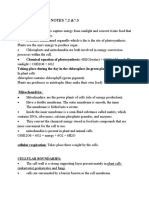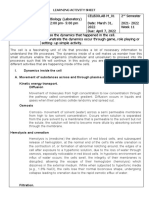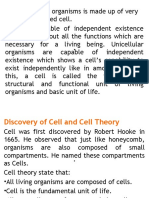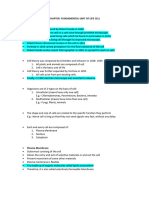Title
Title
Uploaded by
Wei LoonCopyright:
Available Formats
Title
Title
Uploaded by
Wei LoonCopyright
Available Formats
Share this document
Did you find this document useful?
Is this content inappropriate?
Copyright:
Available Formats
Title
Title
Uploaded by
Wei LoonCopyright:
Available Formats
Title Membrane Permeability
Objective 1. To define the solvent, solute, solution, selectively permeable, diffusion, osmosis, concentration gradient, equilibrium, turgid, plasmolyzed, plasmolysis, turgor pressure, tonicity, hypertonic, isotonic, and hypotonic. 2. To describe the effects of hypertonic, isotonic and hypotonic solutions on Elodea leaf cells and onion scale leafs.
Introduction All biological cells are surrounded by a boundary layer called a plasma membrane. The cell membrane is a biological membrane that separates the interior of all cells from the outside environment. Due to the living cells are made up of 70%-85% water, so that all the substances are dissolved in the water and moving enter or leaving the cells. The cell membrane is selectively permeable to ions and organic molecules and controls the movement of substances in and out of the cells. For example, salt and sugar need to dissolve in water before they enter or leave the cells and it is easier for the movement process of the substances.
The cell membrane consists of the phospholipid bilayer with embedded proteins. The phospholipid bilayer contains hydrophobic tail regions (surrounding polar fluid) and hydrophilic head (cytosolic and extracellular faces) of the resulting of bilayer. The bilayer membrane control the polar molecules to across the membrane, due to it is a selective permeable membrane. Some protein molecules in the membrane act as channels or gates to regulate the transport of biomaterials in and out of the cell. The help of using transmembrane protein to overcome the other bigger size molecule to passes through the membrane.
For a cell to survive, it must be constantly supplied with nutrient and metabolic waste products must be removed. All biomolecules that enter or exit the cell encounter
the plasma membrane barrier. Certain small, non-polar molecules can readily diffuse through the membrane. Other molecules, specifically those that are large and polar, require the assistance of protein channels, carriers, gates, and pumps to achieve transport.
All forms of membrane transport can be classified into one of two major groups, which is passive transport and active transport. Passive transport us a molecule or ion that crosses the membrane by moving down a concentration (move from a region of higher concentration through a permeable divider to a region of lower concentration of that solute) or electrochemical gradient and without expenditure of metabolic energy. There have two kind of passive transport which is simple diffusion (involve no protein) and facilitated diffusion (involve protein).
Simple diffusion is an unassisted net movement of a solute from a region where its concentration is higher to a region where its concentration lowers. Simple diffusion occur without the using of energy. It lets gases, non-polar molecules and small polar molecules such as water, carbon dioxide, oxygen or ethanol passes through the membrane. The main factor affecting the diffusion of solute is the size of solute, the polarity of solute and the charge of solute.
Water also can across the selectively membrane by using the process of osmosis. It is permeable to water but not to the dissolved solute. Osmosis is the water move from regions of lower solute concentration to regions of higher solute concentration. Water will tend to move inward because the concentration of solutes is always higher inside a cell than outside. Osmotic movement of water into and out of a cell is related to the osmolarity (relative solute concentration), of the solution in which the cell finds itself.
A concentration gradient is the concentration that exists between a two different areas. When the concentration between both sides is equally the same, the system is said to be equilibrium, there are no net flow of particles or ions in the system. Although the system was equilibrium in the cells, while the particles still flow around and move around. The movement of the particles will not affect the change in the concentration.
Plant cells consist of cell wall which protect the interior and maintain the shape of the cell. The vacuole in plant cells aid as storage of food and nutrient. While the vacuolar membrane is selectively membrane, so that only some of the particles can move in. Water can move in and out though the membrane, this causes the turgor pressure. This mean main pressure of the cell contents against the cell wall in plant cells and bacteria cells, determined by the water content of the vacuole, resulting from osmotic pressure. Therefore the cell was turgid.
Material y y y y y y y Forceps 2 microscope slides 2 coverslips Compound microscope Elodea in tap water 2 dropping bottles od dH2O 2 dropping bottles of 20% sodium chloride (NaCl)
Method 1. A forceps was used to remove two young leaves from the tip of an Elodea plant. 2. One leaf was mounted in a drop of distilled water on a microscope slide and the other in 20% NaCl solution on a second microscope slide. 3. The coverslips were places over both leaves. 4. The leaf in the distilled water was observed with the compound microscope. The medium-power objective was used to focus first and then the high-dry objective was switched. 5. The leaf mounted with 20% NaCl solution was observed now. After several minutes, the cell will have lost water, causing it to become plasmolyzed. (plasmolysis) 6. Deplasmolysis was observed by slowly and gently remove the coverslip from a preparation exhibiting plasmolysis, the salt solution was drained and 2 drops of distilled water was added. 7. After 1 minute, a coverslip was placed on the preparation. Under the examined at high-dry for 5 minute, the result was observed.
Result
Discussion When observe the Elodea leaf under the compound microscope, we can found that the Elodea leaf contain cell wall, plasma membrane, cytoplasm, vacuole and chloroplast. Every organelle in the plant cell has its own function to help the plant cell to survive. The main organelle that we found in the plant cell is the cell wall. It is used to fix the shape of the plant cell. It is tough, usually flexible but sometimes fairly rigid layer that surrounds some types of cells. Plant cell wall is the major in carbohydrate, which is cellulose, hemicellulose and pectin. The cell wall of the plant cell is semi-permeable and permits the passage of small molecules (oxygen and carbon dioxide) and small protein. One of the important cell wall functions is providing strength to the cell. Although the cell wall is rigid in nature, it is also flexible to a certain extent. Besides, the cell wall is the first line of defense for the cell during an attack from pathogens and microorganisms. Its property of being rigid is to prevent pathogens and other harmful foreign bodies from entering. It also offers protection against mechanical stress to the cell.
Before entering the cytoplasm, there have a membrane below the cell wall which is plasma membrane. The plasma membrane function that probably is of greatest significance to the cells is the transportation of materials. This semi-permeable membrane of the cells helps in the transferring of the nutrients and chemicals that are required for the cell functioning. The other foreign materials are obstructed on their path thereby preventing the invasion of the plasma membrane.
Cytoplasm is the interior organelle found in both animal and plant cell. The function cytoplasm is to provide support to the internal structures by being a medium for their suspension. It also help in maintaining the shape and consistency of the cell. Besides, it also stores many chemicals that are inevitable for life.
The two organelles which is vacuole and chloroplast does not found in animal cell. They play a very important for the plant cell. The large vacuole in the plant cell in enclosed by a semi-permeable membrane called tonoplast. The function of the vacuole in the plant cell is to store organic and inorganic substances. The all chemicals involve
organic acid, sugars, mineral salts, oxygen, carbon dioxide, amino acid and waste product substances. It also maintains the internal hydrostatic pressure or turgor within the cell. For chloroplast, it contains an important component of a plant cell called chlorophyll, which is responsible for production of food. It's the chlorophyll which gives the leaves its characteristic green color. It absorbs the sunlight to undergo the process of photosynthesis.
When the Elodea leaf mounted with distilled water, observe under the compound microscope, the plant cell become turgid and rigid. This is because the concentration inside of the vacuole in the plant cell is much higher than concentration outside of the plant cell. When undergoes the process of osmosis, the water will move into the cell membrane then finally to the vacuole. It also creates the turgor pressure that means the vacuole push the cytoplasm against the cell wall and support the structure of plant cell. The cell membrane just can only expend until the maximum that the water molecules cannot moving into the cell. In the other hand, when the plant cell put in 20% of NaCl, the cell will become plasmolyzed. This is due to the plant cell was put in the hypertonic solution, which is high in solute concentration. The cell finally become shrinks together because the water diffuses out from the plant cell by osmosis. This causes the vacuole and the cytoplasm to lose water to the surrounding. This process is known as plasmolysis. The cell becomes flaccid and not turgid anymore. While the cell wall maintain the shape due to it is strong enough.
Due to the concentration gradient, when the plasmolyzed plant cell water immersed into hypotonic solution, the cell will become turgid again, due to the interior of the cell is higher concentration than the concentration at outside environment. Hypotonic is the condition where the content inside the cell having a lower osmotic pressure than a particular fluid. The Elodea cell is to be said deplasmolyzed.
Tonicity is the osmotic pressure or tension of a solution, as in the cells would swell or shrink depending on the tonicity of the environment. In hypotonic solution, the concentration of solute is lower in this solution when compared with others solution. The solutions which are in equal concentration mean it is isotonic. The solution with lower concentration of solute is called hypotonic solution.
Conclusion The solvent, solute, solution, selectively permeable, diffusion, osmosis, concentration gradient, equilibrium, turgid, plasmolyzed, plasmolysis, turgor pressure, tonicity, hypertonic, isotonic, and hypotonic was defined.
Solute is a component of solution, which dissolved substance in the solvent. While solvent is a liquid, solid, or gas that dissolves another solid, liquid, or gaseous solute, resulting in a solution that is soluble in a certain volume of solvent at a specified temperature. Solution is a homogeneous mixture composed on only one phase. In the mixture, a solute is dissolved in the solvent. Selectively permeable mean a feature and a function of the plasma membrane that is essential to maintain homeostasis by regulating the passage of some substances while preventing others from entering the cell.
Diffusion is the movement of the particles across the membrane from a region of higher concentration to a region of lower concentration area. Osmosis is the diffusion of water across the plasma membrane from a region of lower solute concentration to a region of higher solute concentration. The concentration gradient is the difference of concentration of like molecules in two regions. Equilibrium is state of rest or balance due to the equal movement of the particles.
Turgid in another word mean swollen or tumid. It means the plant cell will not burst and just swollen and turgid. Plasmolyzed mean that it undergoes the process of plasmolysis and plasmolysis is the process in plant cells where the plasma membrane pulls away from the cell wall due to the loss of water through osmosis. Turgor pressure mean main pressure of the cell contents against the cell wall in plant cells and bacteria
cells, determined by the water content of the vacuole, resulting from osmotic pressure. Tonicity is the osmotic pressure or tension of a solution, as in the cells would swell or shrink depending on the tonicity of the environment.
When the Elodea leaf in the hypertonic solution, the water in the cell will moving outward causes the cell to shrink, due to Elodea leaf consists of cell wall, so it can maintain the shape of the cell. While in hypotonic solution, the water at the outer will moving inward to the cell, causes the cell to become turgid, but do not burst due to the cell wall maintaining the shape. Lastly, in isotonic solution will not affect the movement of the water because it is equilibrium at the interior and exterior. For overview, under the view of microscope the structures that can be seen are cell wall, plasma membrane, vacuole, cytoplasm and chloroplast. The plant cell like Elodea cell has a membrane that can regulate the movement of water in and out of the cell. The cell wall help to maintain the turgid shaped of plant cell. The absent of cell wall in plant cell, the plant will become rapture and unshaped. Vacuole is important to function in maintain the water balance in the cell. The concentration of solute inside the cell is important to determine whether the plant is in hypertonic, isotonic or hypotonic condition.
Question 1. Were the contents of the vacuole in the Elodea leaf in distilled water hypotonic, isotonic, or hypertonic compared to the water? A: It is isotonic to the water when the content of the vacuole in the Elodea leaf in distilled water.
2. Was the 20% NaCl solution hypertonic, isotonic or hypotonic relative to the cytoplasm? A: The 20% NaCl solution is hypertonic relative to the cytoplasm.
3. If a hypotonic and a hypertonic solution are separated by selectively permeable membrane, which direction will the water move? A: The water will move from hypotonic solution into hypertonic solution if it is separated by the selectively permeable membrane.
4. Name two selectively permeable membranes that are present within the Elodea cells and that were involved in the plasmolysis process. A: The two selectively membrane that is presents within the Elodea cells and that were involved in the plasmolysis process are plasma membrane and vacuole membrane.
Reference 1. Sonia.Nair, Cytoplasm Function, from http://www.buzzle.com/articles/cytoplasmfunction-in-a-cell.html 2. Becker,W.M., Kleinsmith,L.J.,& Hardin,J. (2009), The world of the cell. (7th ed.), San Francisco: Pearson/Benjamin Cummings. 3. Campbell,N.A.,Reece,J.B.,&Mitchell,L.G.(2008), Biology. (8th ed.), San Francisco: Pearson/Benjamin Cummings.
You might also like
- AL4 TransmissionDocument59 pagesAL4 Transmissionericsolver97% (65)
- O Level Biology Notes MapurangaDocument95 pagesO Level Biology Notes Mapurangapeterchiyanja100% (2)
- Biology For Prelims Exam PDFDocument385 pagesBiology For Prelims Exam PDFKatelyn ValeraNo ratings yet
- Site Instruction To Contractor Project Managers (Section-1, 2 & 3)Document3 pagesSite Instruction To Contractor Project Managers (Section-1, 2 & 3)Lakmal Jayashantha100% (2)
- Numeric A Reasoning PracticeDocument9 pagesNumeric A Reasoning Practicemujtaba1101100% (1)
- Cell MembraneDocument10 pagesCell Membraneharshika tembhurneNo ratings yet
- Cell ConstituentsDocument8 pagesCell ConstituentsSanaa SamkoNo ratings yet
- THE CELL MEMBRANE (Coloured)Document6 pagesTHE CELL MEMBRANE (Coloured)tsteadmanNo ratings yet
- O Level Biology Notes With SpecDocument66 pagesO Level Biology Notes With Specshaayaa71% (7)
- Cell Membrane Function and StructureDocument6 pagesCell Membrane Function and Structurecris ibarraNo ratings yet
- Cell Classix Notes Session2 Made by Purnima SharmaDocument4 pagesCell Classix Notes Session2 Made by Purnima Sharmajeetjyoti787No ratings yet
- Chapter 3 Movement in and Out of CellsDocument6 pagesChapter 3 Movement in and Out of CellsWezu heavenNo ratings yet
- Cell Membrane Grade 12Document8 pagesCell Membrane Grade 12Olayinka SalmonNo ratings yet
- AkdogDocument10 pagesAkdognorhain4.aNo ratings yet
- Bio CLASS 8 Cell And, Movement in AND Out OF CELLDocument23 pagesBio CLASS 8 Cell And, Movement in AND Out OF CELLwhoa5530No ratings yet
- Biology Notes Class 9Document5 pagesBiology Notes Class 9lalitha muraliNo ratings yet
- Gene103Lab DiffusionandOsmosisDocument5 pagesGene103Lab DiffusionandOsmosisbodurr571No ratings yet
- Transport MechanismDocument49 pagesTransport Mechanismsadroses1223No ratings yet
- Biology Info Sheet 18.11.23Document5 pagesBiology Info Sheet 18.11.23jhoyvanNo ratings yet
- Cell - The Fundamental Unit of LifeDocument3 pagesCell - The Fundamental Unit of LifeUnknownNo ratings yet
- Egg Membrane Project For 12Document18 pagesEgg Membrane Project For 12Hemanth Kumar100% (1)
- Pergerakan Molekul Dalam Sel TumbuhanDocument36 pagesPergerakan Molekul Dalam Sel TumbuhanSitiKomariahAgustinaNo ratings yet
- Biology For Prelims (Sscstudy - Com)Document385 pagesBiology For Prelims (Sscstudy - Com)Abhisar KhokharNo ratings yet
- Biology UPSC, SSC, and State Level PSC PDFDocument385 pagesBiology UPSC, SSC, and State Level PSC PDFDeepak KumarNo ratings yet
- Year 11 Biology NotesDocument11 pagesYear 11 Biology Notesayaan.huss207No ratings yet
- Bioloy Notes From NCERT (Mahendra Coaching NotesDocument385 pagesBioloy Notes From NCERT (Mahendra Coaching NotesBabu VermaNo ratings yet
- Bio CellDocument5 pagesBio CellAnhad SinghNo ratings yet
- Ch10 Kitabcd Class 8 MSBHSE Science NotesDocument14 pagesCh10 Kitabcd Class 8 MSBHSE Science NotesONE CLICK COMPUTERNo ratings yet
- Lab 4 Drawing of A Cross Section of A Ligustrum Plant Cell Under A Light MicroscopeDocument4 pagesLab 4 Drawing of A Cross Section of A Ligustrum Plant Cell Under A Light MicroscopeMichael TimsonNo ratings yet
- CELL PHYSIOLOGY@starDocument6 pagesCELL PHYSIOLOGY@starDENIS KIPKOSGEINo ratings yet
- The Cellular Level of OrganizationDocument54 pagesThe Cellular Level of OrganizationGraziela Sagun RepuyoNo ratings yet
- GRADE 11 (Supplementary Information)Document3 pagesGRADE 11 (Supplementary Information)Eleina100% (1)
- I. Dynamics Inside The Cell A. Movement of Substances Across and Through Plasma Membrane Kinetic Energy Transport. DiffusionDocument10 pagesI. Dynamics Inside The Cell A. Movement of Substances Across and Through Plasma Membrane Kinetic Energy Transport. DiffusionPrincess Anne ChavezNo ratings yet
- OsmosisDocument3 pagesOsmosisGayathriNo ratings yet
- Cell Structure and Function: Tenets of Cell TheoryDocument9 pagesCell Structure and Function: Tenets of Cell Theoryjey011No ratings yet
- Membrane Integrity Under Osmosis: LaboratoryDocument13 pagesMembrane Integrity Under Osmosis: LaboratoryLiana Macdonald-KainoaNo ratings yet
- Activity 3 Diffusion and OsmosisDocument6 pagesActivity 3 Diffusion and OsmosisThea Calyn WalicanNo ratings yet
- The Cell MembraneDocument9 pagesThe Cell MembraneShuchi HossainNo ratings yet
- Cell TransportDocument19 pagesCell TransportOctavio ManciniNo ratings yet
- ASSIGMENT of Environmental Toxicology 12Document8 pagesASSIGMENT of Environmental Toxicology 12naeem attaNo ratings yet
- CELL TRANSPORT Notes SY 2022 2023Document36 pagesCELL TRANSPORT Notes SY 2022 2023Olitres, John Vincent A.No ratings yet
- Cell Membrane Structure-And FunctionDocument5 pagesCell Membrane Structure-And FunctionEmmanuel MwaleNo ratings yet
- Movement in and Out of CellsDocument10 pagesMovement in and Out of CellsMoni VillalbaNo ratings yet
- Chapter Two ThreeDocument50 pagesChapter Two Threerue pattinsonNo ratings yet
- Cell by Arjun ChauhanDocument25 pagesCell by Arjun ChauhanSharad ChoudharyNo ratings yet
- BiotechnologyDocument14 pagesBiotechnologyLian Gwyneth TomasNo ratings yet
- Pre-Lims ReviewerDocument4 pagesPre-Lims ReviewerANGEL RIZARENo ratings yet
- CellDocument61 pagesCellAbdul Rehman100% (1)
- Cellular TransportDocument6 pagesCellular TransportMikee MercadoNo ratings yet
- Architectural Concept Cabeihm Bsu NasugbuDocument4 pagesArchitectural Concept Cabeihm Bsu NasugbuArrnold DominguezNo ratings yet
- Notes For CH. CellDocument5 pagesNotes For CH. Celladityamanik.121No ratings yet
- Cells 3Document66 pagesCells 3KEANNA RUBIANo ratings yet
- Fundamental Unit of Life Notes (C.W)Document3 pagesFundamental Unit of Life Notes (C.W)Ayushman MohantyNo ratings yet
- Plasma Membrane: A Physical BarrierDocument3 pagesPlasma Membrane: A Physical BarrierDiane OrsuaNo ratings yet
- Reviewer in Biology 1Document8 pagesReviewer in Biology 1Ainah M. MaruhomNo ratings yet
- A Tour of The CellDocument15 pagesA Tour of The CellMegan GohNo ratings yet
- Cell MembraneDocument3 pagesCell MembraneQaran PrintingNo ratings yet
- Cell StructureDocument6 pagesCell StructureAdit KumarNo ratings yet
- Chapter 5: Homeostasis and Transport Lesson 5.2: Cell Transport-Passive and ActiveDocument10 pagesChapter 5: Homeostasis and Transport Lesson 5.2: Cell Transport-Passive and ActiveVanshika VermaNo ratings yet
- Biology Notes 2Document9 pagesBiology Notes 2Nessa NessaNo ratings yet
- B1 Cell Structure and Transport Glossary: WWW - Oxfordsecondary.co - Uk/acknowledgementsDocument2 pagesB1 Cell Structure and Transport Glossary: WWW - Oxfordsecondary.co - Uk/acknowledgementsGrace BarnardNo ratings yet
- Anaphy LecDocument6 pagesAnaphy LecfilesNo ratings yet
- Snakes On A PlaneDocument1 pageSnakes On A Planeapi-176649955No ratings yet
- Consulting Services For The Data Gathering, Surveys and Investigations For The Feasibility Study ofDocument47 pagesConsulting Services For The Data Gathering, Surveys and Investigations For The Feasibility Study ofManuel BrianNo ratings yet
- Mini Project BrigeDocument6 pagesMini Project BrigeShakti prasad GuruNo ratings yet
- Insulation Systems For Refrigerant PipingDocument10 pagesInsulation Systems For Refrigerant PipingBryan VertuodasoNo ratings yet
- The Campbeltown Shipbuilding CompanyDocument4 pagesThe Campbeltown Shipbuilding CompanyKintyre On RecordNo ratings yet
- Bhusawal Railway TimetableDocument2 pagesBhusawal Railway TimetablePankaj Sharadchandra Mahajan100% (1)
- GTH-1544 Spec 2015-2016Document2 pagesGTH-1544 Spec 2015-2016Lazaro GutierrezNo ratings yet
- Selection LetterDocument2 pagesSelection LetterLogesh LokiNo ratings yet
- Routes in Central and South Bristol Walk 2 - Sculpture TrailDocument11 pagesRoutes in Central and South Bristol Walk 2 - Sculpture TrailBogdanBNo ratings yet
- E.R. Johnson - American Military Transport Aircraft Since 1925 (2013)Document489 pagesE.R. Johnson - American Military Transport Aircraft Since 1925 (2013)Stotza95% (20)
- May 13, 2011 Strathmore TimesDocument32 pagesMay 13, 2011 Strathmore TimesStrathmore TimesNo ratings yet
- SSP 536 The Golf SVDocument52 pagesSSP 536 The Golf SVMario S.M.No ratings yet
- Training Pilots For ResilienceDocument11 pagesTraining Pilots For ResilienceAlexis PadillaNo ratings yet
- Balanced Cantilever Bridge - SOFiSTiK TUTORiALSDocument15 pagesBalanced Cantilever Bridge - SOFiSTiK TUTORiALSKaterina VeljanovskaNo ratings yet
- ADEN Duties and SSEDocument26 pagesADEN Duties and SSEThiyagarajan kNo ratings yet
- Ambai 1Document63 pagesAmbai 1sheikNo ratings yet
- 2dxl Super Loader Backhoe LoaderDocument8 pages2dxl Super Loader Backhoe LoaderNiranjan TailorNo ratings yet
- Union Square Bus Station - Fujairah ÕP (C - %@ U $Õ ( R'? @ (Document2 pagesUnion Square Bus Station - Fujairah ÕP (C - %@ U $Õ ( R'? @ (Dubai Q&ANo ratings yet
- On The Dynamics of Railway Vehicles On Tracks With Lateral IrregularitiesDocument10 pagesOn The Dynamics of Railway Vehicles On Tracks With Lateral IrregularitiesStefan TudoracheNo ratings yet
- AGV Brochure English Reprint Port StrategyDocument4 pagesAGV Brochure English Reprint Port Strategyyokito85No ratings yet
- 9Document118 pages9juan carlos zavalaNo ratings yet
- CH Five Costing, Pricing and Rate Making in Freight TransportationDocument26 pagesCH Five Costing, Pricing and Rate Making in Freight TransportationDsh ShNo ratings yet
- T17 - Cargo Oil PumpDocument2 pagesT17 - Cargo Oil PumpZielmark Sdn BhdNo ratings yet
- Project:-Rabab Harweel Power Plant & HRSG Project (Contract No.C311530)Document7 pagesProject:-Rabab Harweel Power Plant & HRSG Project (Contract No.C311530)Nadim JilaniNo ratings yet
- Corresponding Supporting ScheduleDocument3 pagesCorresponding Supporting Schedulealmira garciaNo ratings yet
- Sydenham To Bankstown Urban Renewal Corridor Strategy Built Form Transect Diagram 2016 04 PDFDocument7 pagesSydenham To Bankstown Urban Renewal Corridor Strategy Built Form Transect Diagram 2016 04 PDFAlla ElfallahNo ratings yet
- W B W W B: 4. Calculation ExampleDocument3 pagesW B W W B: 4. Calculation ExamplePbNo ratings yet

























































































